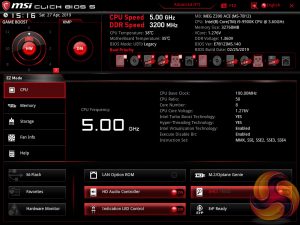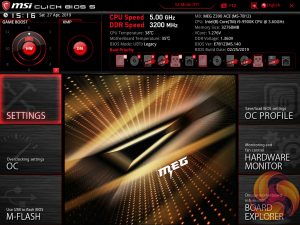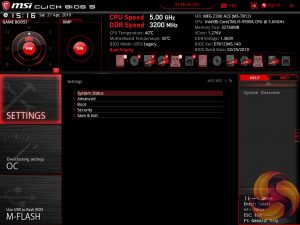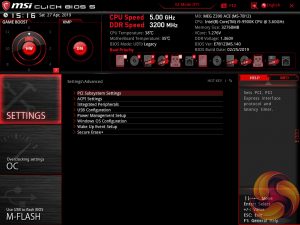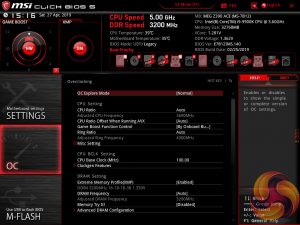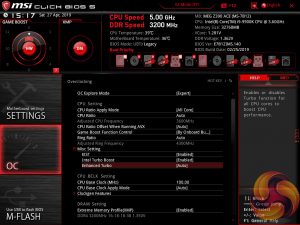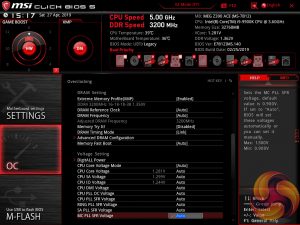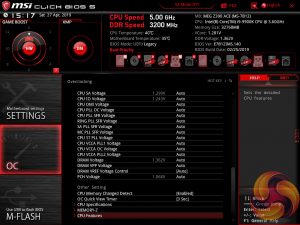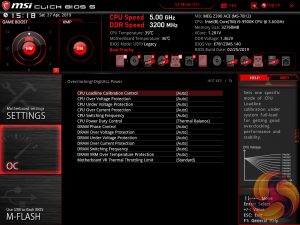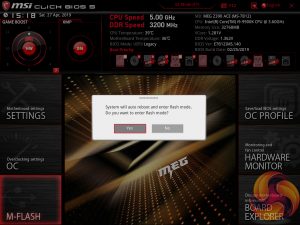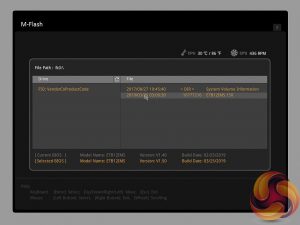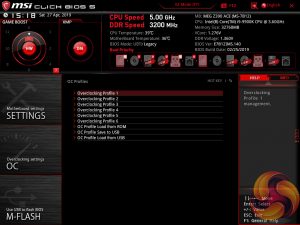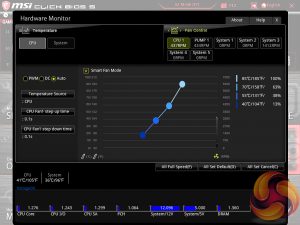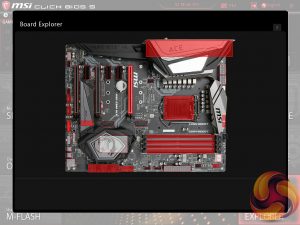MSI’s UEFI has remained relatively consistent across its range of high-end motherboards for Intel platforms for the last few years. The MSI MEG Z390 ACE sports version 5 of MSI’s Click BIOS which launches into an EZ Mode splash screen with an option to head into the advanced mode with the press of F7.
Settings has a number of useful settings for booting and integrated peripherals. The Advanced entry has the most sub menus and options to play with including the ability to toggle various different compatibility modes for storage and USB devices.
The real substance of the BIOS for most users is found in the OC tab where frequency and voltage settings related to the CPU, DRAM and other System components are found. It is advisable to toggle the “OC Explore Mode” into Expert straight away since the Normal mode does hide some useful options.
The most important of those is the ability to pick how CPU voltage is applied, by enabling Expert mode you can pick from a number of voltage modes including Adaptive, Override, Offset, Adaptive + Offset or Override + Offset.
The range of LLC options is extensive too, with Mode 1 (most aggressive) to Mode 8 (least aggressive) as well as an option for No overvolting, which is even less aggressive on the voltage than Mode 8. From our testing with override voltages, mode 3 ensures no droop from what is programmed in the BIOS, if anything it rises a little higher than what's specified, while mode 4 ends up being slightly under. The visual diagram MSI provides within the BIOS is useful in ascertaining the approximate behaviour of each CPU LLC mode.
The Game Boost “overclocking button/dial” settings can be toggled from within the UEFI environment but this board also gets a physical switch. That said, overclocking profiles from Game Boost are too aggressive in terms of voltage application and even beginner overclockers can probably achieve better results given an hour or two of online research and tweaking.
MSI has an “enhanced Turbo” setting that is working away in the background under the guise of “Auto” from the get-go, whether an XMP profile is set or not. Somewhat surprising is the fact that even if you disable enhanced Turbo, MSI still flouts Intel's Turbo specification and locks the Turbo frequency in at 4.7GHz all-core on the Core i9 9900K, well beyond the rated 95W TDP. For reference a typical Intel Turbo runs at 4.6~4.7GHz all-core for about 30 seconds before backing down to around 4.2~4.3GHz.
Enhanced Turbo being enabled, instead of Auto, is even more aggressive, opting for a 5GHz all-core turbo with around 1.36v – certainly not for the faint of heart. Amusingly, our system constantly crashed with Enhanced Turbo enabled, so it is advisable that the user does not enable this setting.
M-Flash forces you to reboot to enter the flashing process is somewhat tedious though in practice all motherboard vendors will eventually reboot multiple times during the flashing process to apply the updates. However, you can’t view any of the M-Flash options or interface without conducting a reboot, whereas most vendors will at least allow you to navigate around in the interface, see what options are available to you and even start the flash, before a reboot is eventually required.
Unlike some rival solutions you can’t view local drives in M-Flash to source the update file or update directly over the internet; MSI would benefit from bolstering the functionality of it’s M-Flash utility with local drive and internet-based updates.
The OC Profile section hasn’t changed a great deal in successive generations, it still allows you to save OC profiles to blank slots, load in OC profiles from a USB stick or export them to a USB stick. It’s a useful capability that should facilitate sharing of decent OC profiles on forums and across the internet more generally.
The last two tiles of the MSI UEFI refer to visual tools. Board Explorer is a visual interface for seeing what is connected to the various sections of the motherboard and some information about those connected entities. Hardware Monitor has more practical use in that it’s the primary method of changing fan profiles within the UEFI environment for each of the seven fan headers.
The fan controls are adequate for this motherboard allowing you to change the temperature source for each temperature-guided fan profile and the “step-up” time between each of the adjustment thresholds (hysteresis).
The only concern is that there isn’t an easily accessible set of fan profiles – there’s a default (auto-type) SMART fan mode or full speed, and the ability to pick between DC or PWM. However, some more traditional pre-calculated fan profiles like Quiet, Normal and Turbo would be well founded and make fan tuning an easier task.
A summary of UEFI changes made in the session is presented to the user before they exit which is helpful and intuitive.
 KitGuru KitGuru.net – Tech News | Hardware News | Hardware Reviews | IOS | Mobile | Gaming | Graphics Cards
KitGuru KitGuru.net – Tech News | Hardware News | Hardware Reviews | IOS | Mobile | Gaming | Graphics Cards


